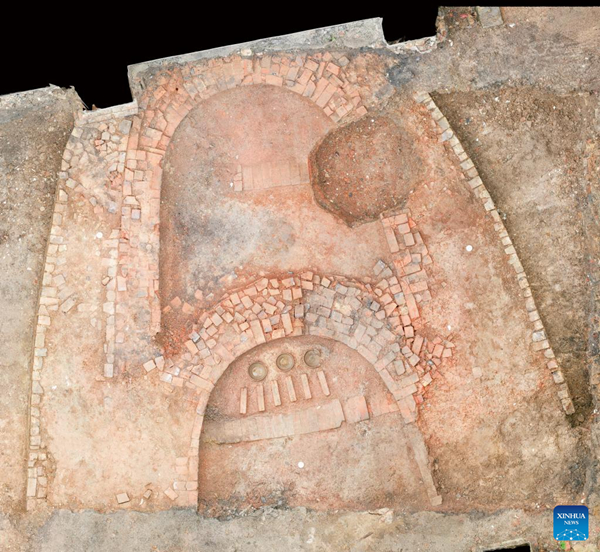


Site groups of porcelain production in Jingdezhen

The remains of a Qing Dynasty kiln in Jingdezhen City, Jiangxi Province Photo: XINHUA
In 2024, six archaeological organizations collaborated to conduct large-scale archaeological work at multiple locations in Jingdezhen, Jiangxi Province, achieving significant results. Building on earlier archaeological work, recent excavations at the imperial kiln factory, Luomaqiao, and Guanyinge sites have yielded new insights into the development of Jingdezhen’s porcelain industry.
The excavation of the imperial kiln factory site is nearly complete, revealing substantial remains of clay production from the Yongle period (1403–1424), as well as strata from the early, middle, and late Ming Dynasty (1368–1644) and the Qing Dynasty (1644–1912). These findings have filled many gaps in the historical record and advanced the systematic study of the porcelain industry in Jingdezhen.
The Luomaqiao site, a long-term production area for folk kilns in the town, uncovered new architectural features from the late Yuan Dynasty (1271–1368), a gourd kiln [so named for its gourd-shaped structure—narrow at the top and wider at the bottom] from the mid-Ming period, and kiln remains from the Qing Dynasty. At the Guanyinge site, a relatively complete workshop was discovered. Excavations here revealed that the porcelain industry gradually shifted and concentrated from surrounding areas to the town itself. Recent discoveries have also identified strata from the Song (960–1127) and Yuan periods, confirming that Jingdezhen already had a dense concentration of porcelain workshops during the Song Dynasty.
The excavation also included two categories of sites: religious sites within the town, such as the Mazu Temple [dedicated to Mazu, the Chinese sea goddess and protector of fishermen, sailors, and travellers—widely worshiped in coastal regions], the mosque, and the Siwang Temple [dedicated to the worship of a deity associated with water and maritime trade], as well as suburban sites like the Jiaotan site [the ancient firewood supply area for Jingdezhen], two dock relics, the Changming Dawukeng porcelain stone mining area, the Gaoling Mountain kaolin mining and processing site, and the nearby Dongbu dock.
At the core of settlement archaeology is human activity, to which the porcelain production chain is deeply connected. The three religious sites underscore the significant role that human elements played in the complete porcelain production and trade system.
It was once believed that the Mazu Temple was built during the reign of Emperor Kangxi of the Qing Dynasty, but recent excavations revealed that its construction dates back to the Wanli period of the Ming Dynasty. This coincides with the rise of the Manila galleon trade, which began at the Yuegang port in Fujian Province. Fujian merchants came to Jingdezhen to place orders, settled there, and specifically engaged in porcelain trade, bringing the worship of Mazu with them.
Similarly, the mosque’s construction was also confirmed to have occurred during the reigns of the Kangxi (r. 1661–1722) and Qianlong (r. 1736–1796) emperors, linked to the settlement of large merchant groups, likely from external trade centers in the northwest or coastal regions. The current mosque site dates from the Qianlong period, but earlier structures date to the Kangxi period, indicated by changes to the column grid between the Kangxi and Qianlong periods, which suggest reconstruction efforts over a short time span. Excavations in the earlier layers, which predate the early Qing period, uncovered Arabic-style magic square porcelain fragments [porcelain found in China featuring Arabic inscriptions or symbols, believed to represent a fusion of Chinese porcelain production and Arabian or Islamic cultural elements], along with official-molded and folk-fired porcelain [a practice wherein most porcelain items were shaped and molded at the imperial kilns, then fired at folk kilns]. These findings suggest that the area was originally a high-level porcelain production workshop, which was later converted into a mosque, highlighting the intersection of religion and production.
The Siwang Temple represents the worship of the water deity brought by the Nanchang ship guild, symbolizing Jingdezhen’s development into a standard industrial town that combined both production and commerce. Excavations at porcelain clay sites, kaolin sites, and the firewood factory are crucial steps in piecing together Jingdezhen’s porcelain production system. The city’s highly specialized production model reflects an early stage of industrialization.
These discoveries reveal that Jingdezhen developed a production model in which the town focused on molding and firing porcelain, while raw material extraction and processing took place several dozen kilometers away, creating a large-scale division of labor.
Qin Dashu is a distinguished professor from the School of Archaeology and Museology at Jingdezhen Ceramic University.
Copyright©2023 CSSN All Rights Reserved